lock BMW 550I SEDAN 2015 Owner's Manual
[x] Cancel search | Manufacturer: BMW, Model Year: 2015, Model line: 550I SEDAN, Model: BMW 550I SEDAN 2015Pages: 277, PDF Size: 5.63 MB
Page 61 of 277
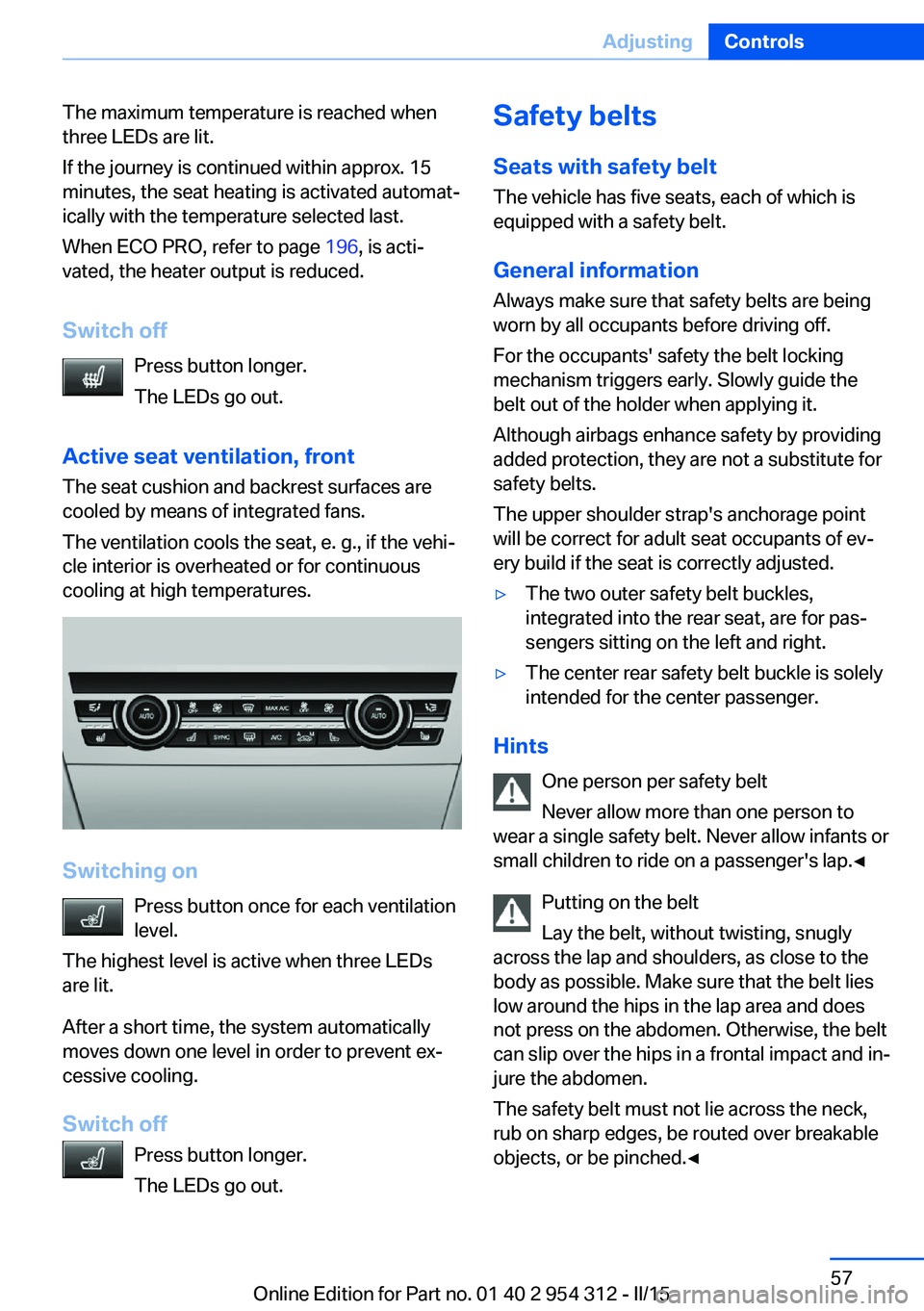
The maximum temperature is reached when
three LEDs are lit.
If the journey is continued within approx. 15
minutes, the seat heating is activated automat‚Äź
ically with the temperature selected last.
When ECO PRO, refer to page 196, is acti‚Äź
vated, the heater output is reduced.
Switch off Press button longer.
The LEDs go out.
Active seat ventilation, front The seat cushion and backrest surfaces are
cooled by means of integrated fans.
The ventilation cools the seat, e. g., if the vehi‚Äź
cle interior is overheated or for continuous
cooling at high temperatures.
Switching on
Press button once for each ventilation
level.
The highest level is active when three LEDs
are lit.
After a short time, the system automatically
moves down one level in order to prevent ex‚Äź
cessive cooling.
Switch off Press button longer.
The LEDs go out.
Safety belts
Seats with safety belt
The vehicle has five seats, each of which is
equipped with a safety belt.
General information
Always make sure that safety belts are being
worn by all occupants before driving off.
For the occupants' safety the belt locking
mechanism triggers early. Slowly guide the
belt out of the holder when applying it.
Although airbags enhance safety by providing
added protection, they are not a substitute for
safety belts.
The upper shoulder strap's anchorage point
will be correct for adult seat occupants of ev‚Äź
ery build if the seat is correctly adjusted.‚Ė∑The two outer safety belt buckles,
integrated into the rear seat, are for pas‚Äź
sengers sitting on the left and right.‚Ė∑The center rear safety belt buckle is solely
intended for the center passenger.
Hints
One person per safety belt
Never allow more than one person to
wear a single safety belt. Never allow infants or
small children to ride on a passenger's lap.‚óÄ
Putting on the belt
Lay the belt, without twisting, snugly
across the lap and shoulders, as close to the
body as possible. Make sure that the belt lies
low around the hips in the lap area and does
not press on the abdomen. Otherwise, the belt
can slip over the hips in a frontal impact and in‚Äź
jure the abdomen.
The safety belt must not lie across the neck,
rub on sharp edges, be routed over breakable
objects, or be pinched.‚óÄ
Seite 57AdjustingControls57
Online Edition for Part no. 01 40 2 954 312 - II/15
Page 66 of 277
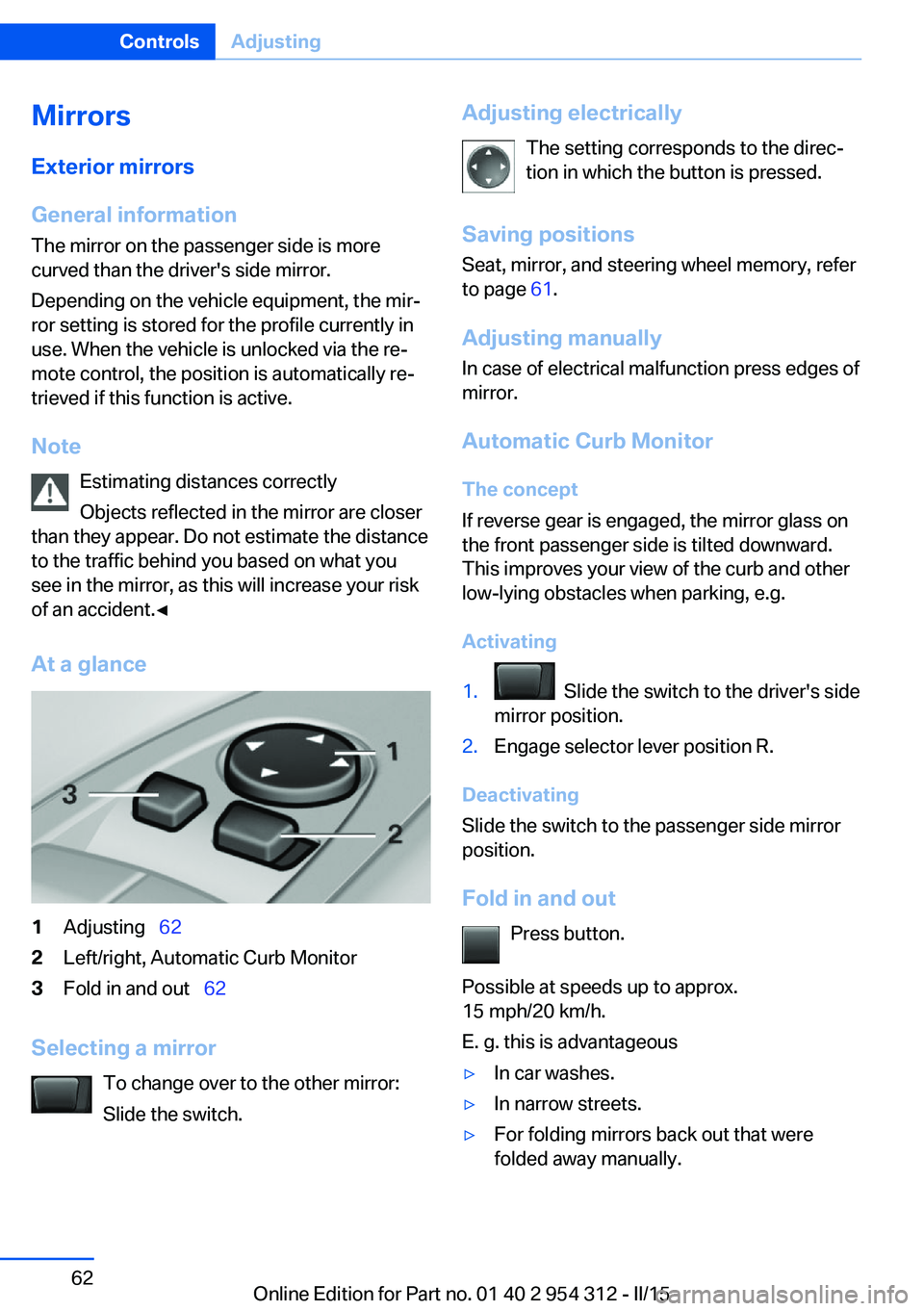
Mirrors
Exterior mirrors
General information The mirror on the passenger side is more
curved than the driver's side mirror.
Depending on the vehicle equipment, the mir‚Äź
ror setting is stored for the profile currently in
use. When the vehicle is unlocked via the re‚Äź
mote control, the position is automatically re‚Äź
trieved if this function is active.
Note Estimating distances correctly
Objects reflected in the mirror are closer
than they appear. Do not estimate the distance
to the traffic behind you based on what you
see in the mirror, as this will increase your risk
of an accident.‚óÄ
At a glance1Adjusting‚Äā‚ÄÖ 622Left/right, Automatic Curb Monitor3Fold in and out‚Äā‚ÄÖ 62
Selecting a mirror
To change over to the other mirror:
Slide the switch.
Adjusting electrically
The setting corresponds to the direc‚Äź
tion in which the button is pressed.
Saving positions
Seat, mirror, and steering wheel memory, refer
to page 61.
Adjusting manually In case of electrical malfunction press edges of
mirror.
Automatic Curb Monitor
The concept
If reverse gear is engaged, the mirror glass on
the front passenger side is tilted downward.
This improves your view of the curb and other
low-lying obstacles when parking, e.g.
Activating1. Slide the switch to the driver's side
mirror position.2.Engage selector lever position R.
Deactivating
Slide the switch to the passenger side mirror
position.
Fold in and out Press button.
Possible at speeds up to approx.
15 mph/20 km/h.
E. g. this is advantageous
‚Ė∑In car washes.‚Ė∑In narrow streets.‚Ė∑For folding mirrors back out that were
folded away manually.Seite 62ControlsAdjusting62
Online Edition for Part no. 01 40 2 954 312 - II/15
Page 69 of 277
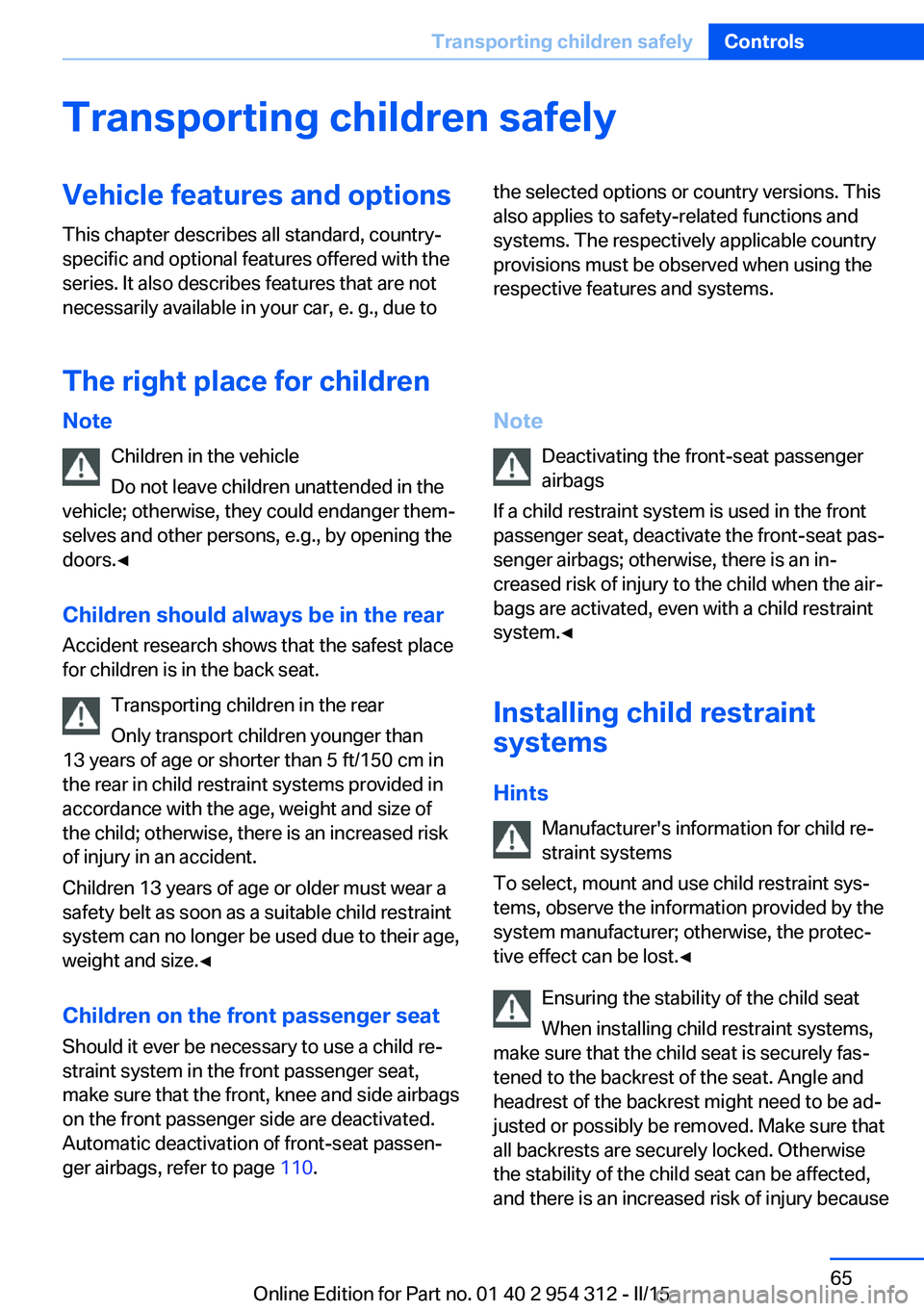
Transporting children safelyVehicle features and optionsThis chapter describes all standard, country-
specific and optional features offered with the
series. It also describes features that are not
necessarily available in your car, e. g., due tothe selected options or country versions. This
also applies to safety-related functions and
systems. The respectively applicable country
provisions must be observed when using the
respective features and systems.
The right place for children
Note
Children in the vehicle
Do not leave children unattended in the
vehicle; otherwise, they could endanger them‚Äź
selves and other persons, e.g., by opening the
doors.‚óÄ
Children should always be in the rear Accident research shows that the safest place
for children is in the back seat.
Transporting children in the rear
Only transport children younger than
13 years of age or shorter than 5 ft/150 cm in
the rear in child restraint systems provided in
accordance with the age, weight and size of
the child; otherwise, there is an increased risk
of injury in an accident.
Children 13 years of age or older must wear a
safety belt as soon as a suitable child restraint
system can no longer be used due to their age,
weight and size.‚óÄ
Children on the front passenger seat
Should it ever be necessary to use a child re‚Äź
straint system in the front passenger seat,
make sure that the front, knee and side airbags
on the front passenger side are deactivated.
Automatic deactivation of front-seat passen‚Äź
ger airbags, refer to page 110.Note
Deactivating the front-seat passenger
airbags
If a child restraint system is used in the front
passenger seat, deactivate the front-seat pas‚Äź
senger airbags; otherwise, there is an in‚Äź
creased risk of injury to the child when the air‚Äź
bags are activated, even with a child restraint
system.‚óÄ
Installing child restraint
systems
Hints Manufacturer's information for child re‚Äźstraint systems
To select, mount and use child restraint sys‚Äź
tems, observe the information provided by the
system manufacturer; otherwise, the protec‚Äź
tive effect can be lost.‚óÄ
Ensuring the stability of the child seat
When installing child restraint systems,
make sure that the child seat is securely fas‚Äź
tened to the backrest of the seat. Angle and
headrest of the backrest might need to be ad‚Äź
justed or possibly be removed. Make sure that
all backrests are securely locked. Otherwise
the stability of the child seat can be affected,
and there is an increased risk of injury becauseSeite 65Transporting children safelyControls65
Online Edition for Part no. 01 40 2 954 312 - II/15
Page 70 of 277
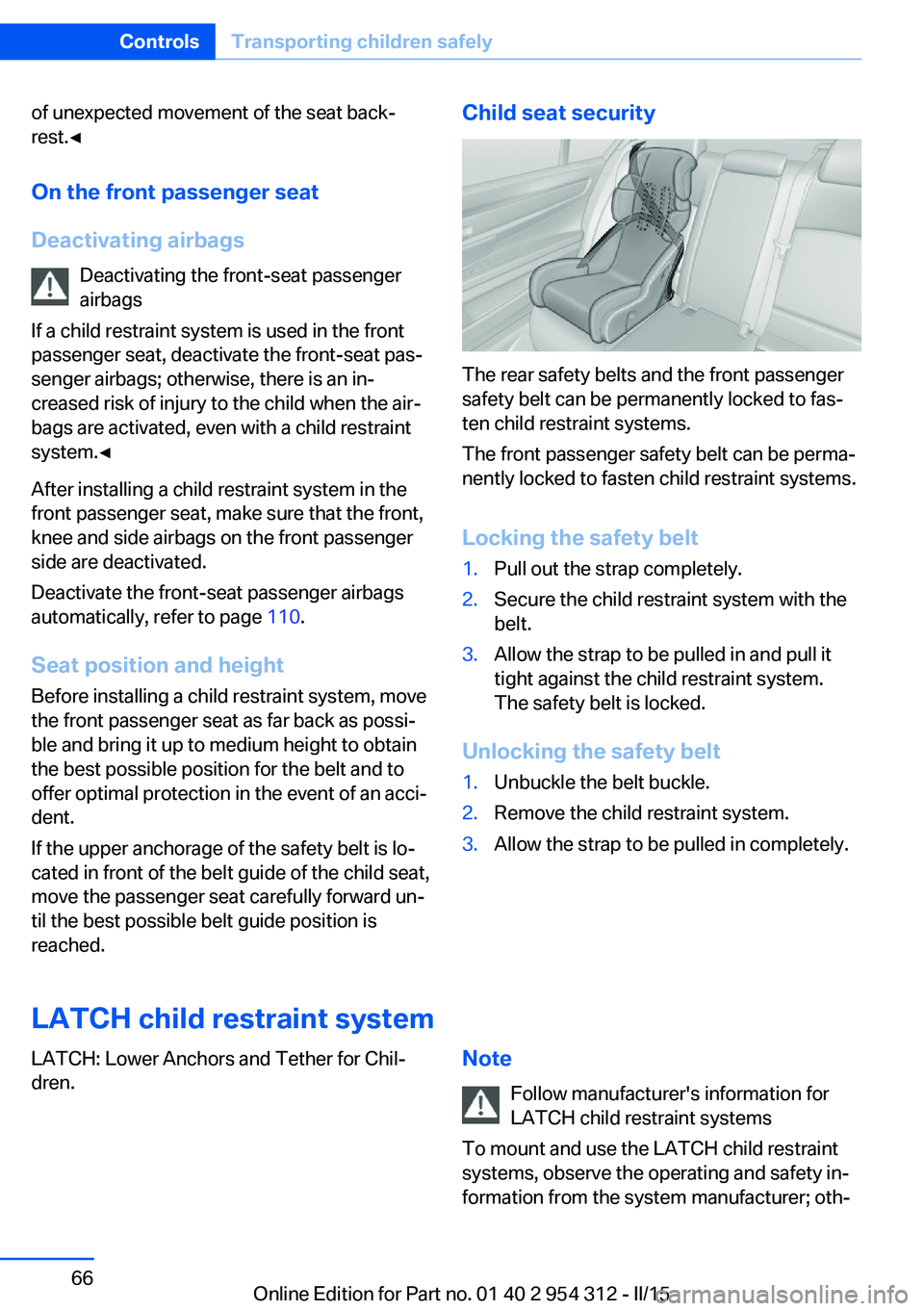
of unexpected movement of the seat back‚Äź
rest.‚óÄ
On the front passenger seat
Deactivating airbags Deactivating the front-seat passenger
airbags
If a child restraint system is used in the front
passenger seat, deactivate the front-seat pas‚Äź
senger airbags; otherwise, there is an in‚Äź
creased risk of injury to the child when the air‚Äź
bags are activated, even with a child restraint
system.‚óÄ
After installing a child restraint system in the
front passenger seat, make sure that the front,
knee and side airbags on the front passenger
side are deactivated.
Deactivate the front-seat passenger airbags automatically, refer to page 110.
Seat position and height
Before installing a child restraint system, move
the front passenger seat as far back as possi‚Äź
ble and bring it up to medium height to obtain
the best possible position for the belt and to
offer optimal protection in the event of an acci‚Äź
dent.
If the upper anchorage of the safety belt is lo‚Äź
cated in front of the belt guide of the child seat,
move the passenger seat carefully forward un‚Äź
til the best possible belt guide position is
reached.Child seat security
The rear safety belts and the front passenger
safety belt can be permanently locked to fas‚Äź
ten child restraint systems.
The front passenger safety belt can be perma‚Äź
nently locked to fasten child restraint systems.
Locking the safety belt
1.Pull out the strap completely.2.Secure the child restraint system with the
belt.3.Allow the strap to be pulled in and pull it
tight against the child restraint system.
The safety belt is locked.
Unlocking the safety belt
1.Unbuckle the belt buckle.2.Remove the child restraint system.3.Allow the strap to be pulled in completely.
LATCH child restraint system
LATCH: Lower Anchors and Tether for Chil‚Äź
dren.Note
Follow manufacturer's information for
LATCH child restraint systems
To mount and use the LATCH child restraint
systems, observe the operating and safety in‚Äź
formation from the system manufacturer; oth‚ÄźSeite 66ControlsTransporting children safely66
Online Edition for Part no. 01 40 2 954 312 - II/15
Page 72 of 277
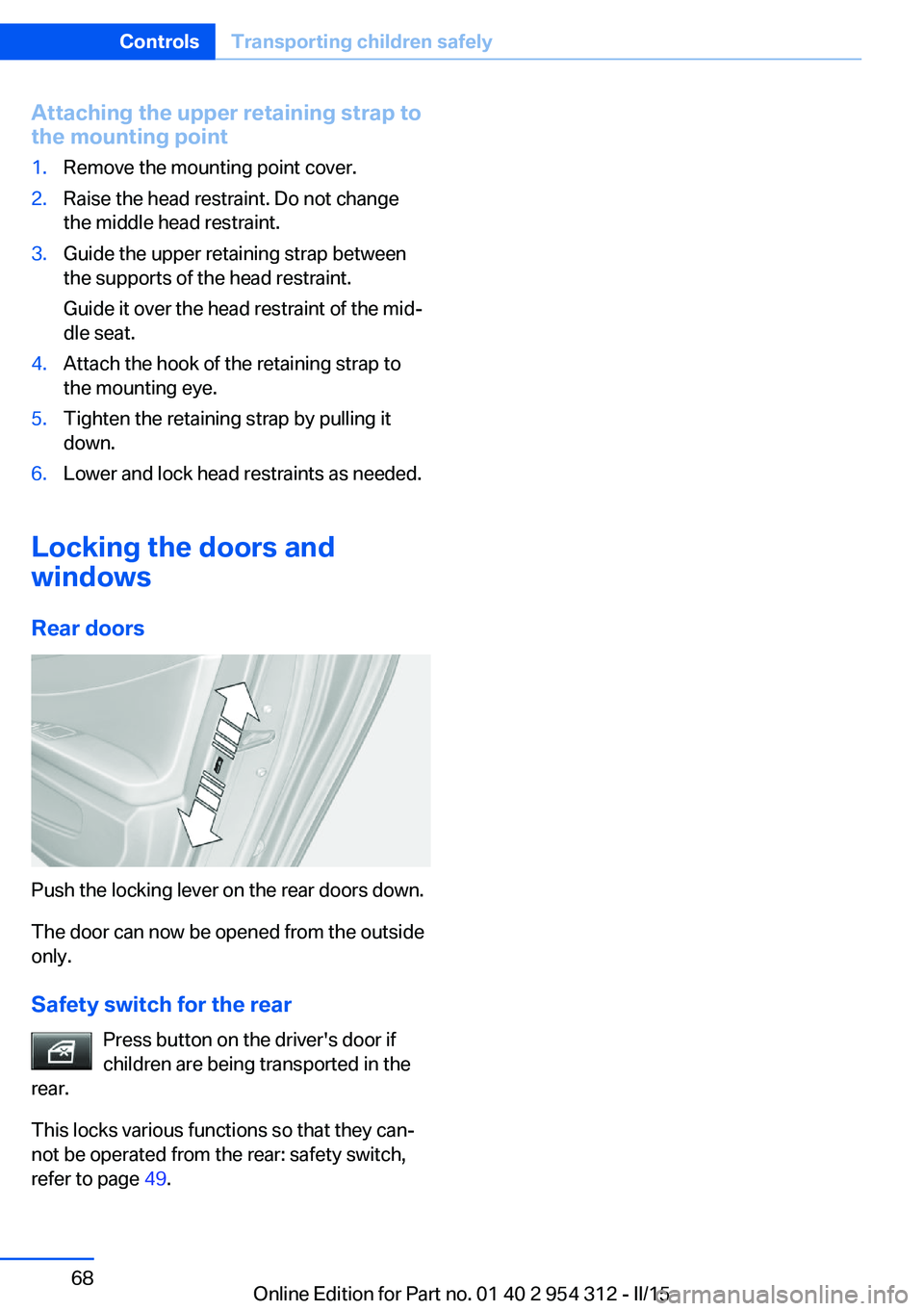
Attaching the upper retaining strap to
the mounting point1.Remove the mounting point cover.2.Raise the head restraint. Do not change
the middle head restraint.3.Guide the upper retaining strap between
the supports of the head restraint.
Guide it over the head restraint of the mid‚Äź
dle seat.4.Attach the hook of the retaining strap to
the mounting eye.5.Tighten the retaining strap by pulling it
down.6.Lower and lock head restraints as needed.
Locking the doors and
windows
Rear doors
Push the locking lever on the rear doors down.
The door can now be opened from the outside
only.
Safety switch for the rear Press button on the driver's door if
children are being transported in the
rear.
This locks various functions so that they can‚Äź
not be operated from the rear: safety switch,
refer to page 49.
Seite 68ControlsTransporting children safely68
Online Edition for Part no. 01 40 2 954 312 - II/15
Page 73 of 277
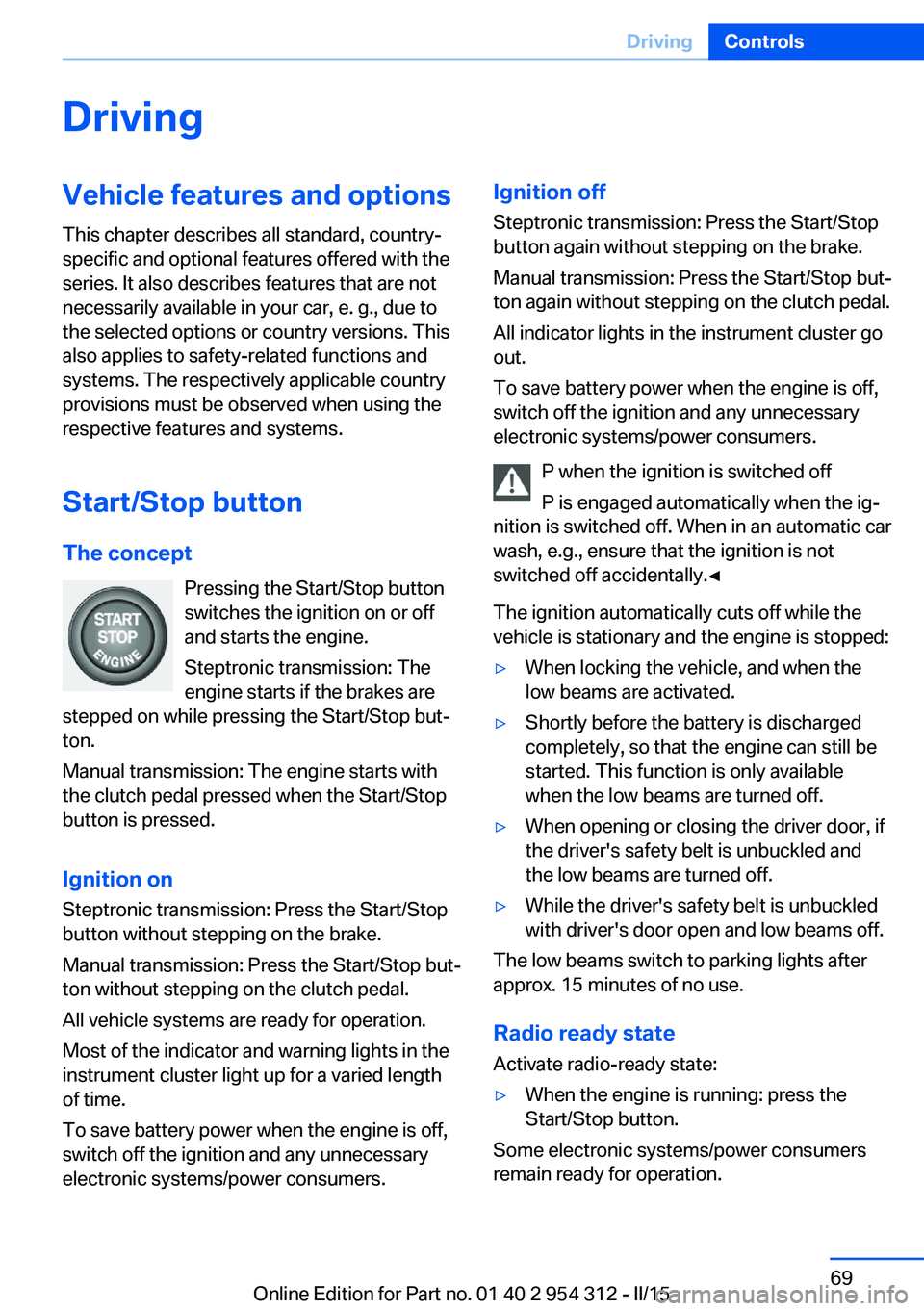
DrivingVehicle features and options
This chapter describes all standard, country-
specific and optional features offered with the
series. It also describes features that are not
necessarily available in your car, e. g., due to
the selected options or country versions. This
also applies to safety-related functions and
systems. The respectively applicable country
provisions must be observed when using the
respective features and systems.
Start/Stop button The concept Pressing the Start/Stop button
switches the ignition on or off
and starts the engine.
Steptronic transmission: The
engine starts if the brakes are
stepped on while pressing the Start/Stop but‚Äź
ton.
Manual transmission: The engine starts with
the clutch pedal pressed when the Start/Stop
button is pressed.
Ignition onSteptronic transmission: Press the Start/Stop
button without stepping on the brake.
Manual transmission: Press the Start/Stop but‚Äź
ton without stepping on the clutch pedal.
All vehicle systems are ready for operation.
Most of the indicator and warning lights in the
instrument cluster light up for a varied length
of time.
To save battery power when the engine is off,
switch off the ignition and any unnecessary
electronic systems/power consumers.Ignition off
Steptronic transmission: Press the Start/Stop
button again without stepping on the brake.
Manual transmission: Press the Start/Stop but‚Äź
ton again without stepping on the clutch pedal.
All indicator lights in the instrument cluster go
out.
To save battery power when the engine is off,
switch off the ignition and any unnecessary
electronic systems/power consumers.
P when the ignition is switched off
P is engaged automatically when the ig‚Äź
nition is switched off. When in an automatic car wash, e.g., ensure that the ignition is not
switched off accidentally.‚óÄ
The ignition automatically cuts off while the
vehicle is stationary and the engine is stopped:‚Ė∑When locking the vehicle, and when the
low beams are activated.‚Ė∑Shortly before the battery is discharged
completely, so that the engine can still be
started. This function is only available
when the low beams are turned off.‚Ė∑When opening or closing the driver door, if
the driver's safety belt is unbuckled and
the low beams are turned off.‚Ė∑While the driver's safety belt is unbuckled
with driver's door open and low beams off.
The low beams switch to parking lights after
approx. 15 minutes of no use.
Radio ready state
Activate radio-ready state:
‚Ė∑When the engine is running: press the
Start/Stop button.
Some electronic systems/power consumers
remain ready for operation.
Seite 69DrivingControls69
Online Edition for Part no. 01 40 2 954 312 - II/15
Page 74 of 277
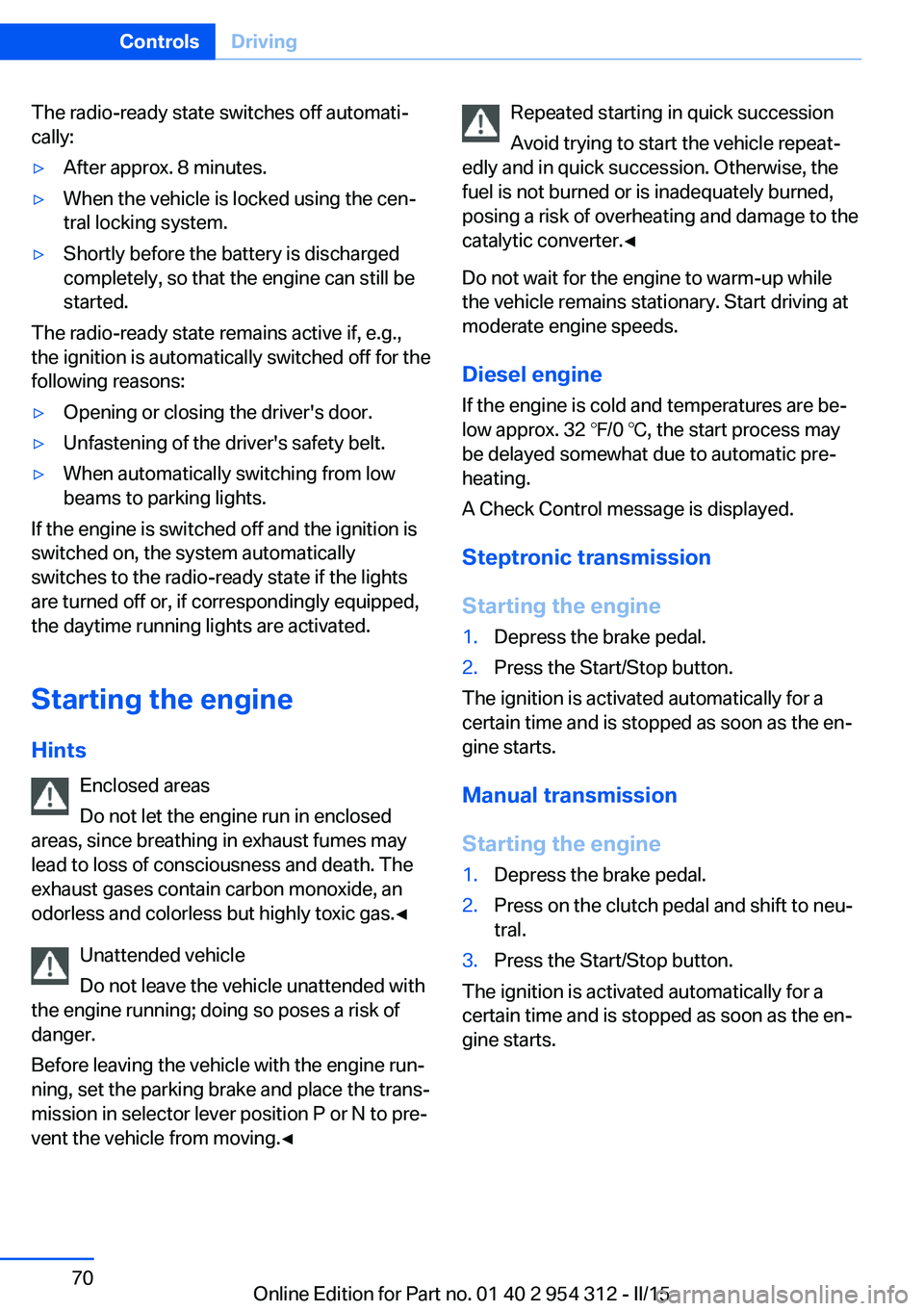
The radio-ready state switches off automati‚Äź
cally:‚Ė∑After approx. 8 minutes.‚Ė∑When the vehicle is locked using the cen‚Äź
tral locking system.‚Ė∑Shortly before the battery is discharged
completely, so that the engine can still be
started.
The radio-ready state remains active if, e.g.,
the ignition is automatically switched off for the
following reasons:
‚Ė∑Opening or closing the driver's door.‚Ė∑Unfastening of the driver's safety belt.‚Ė∑When automatically switching from low
beams to parking lights.
If the engine is switched off and the ignition is
switched on, the system automatically
switches to the radio-ready state if the lights
are turned off or, if correspondingly equipped,
the daytime running lights are activated.
Starting the engine
Hints Enclosed areas
Do not let the engine run in enclosed
areas, since breathing in exhaust fumes may
lead to loss of consciousness and death. The
exhaust gases contain carbon monoxide, an
odorless and colorless but highly toxic gas.‚óÄ
Unattended vehicle
Do not leave the vehicle unattended with
the engine running; doing so poses a risk of
danger.
Before leaving the vehicle with the engine run‚Äź
ning, set the parking brake and place the trans‚Äź
mission in selector lever position P or N to pre‚Äź
vent the vehicle from moving.‚óÄ
Repeated starting in quick succession
Avoid trying to start the vehicle repeat‚Äź
edly and in quick succession. Otherwise, the
fuel is not burned or is inadequately burned,
posing a risk of overheating and damage to the
catalytic converter.‚óÄ
Do not wait for the engine to warm-up while
the vehicle remains stationary. Start driving at
moderate engine speeds.
Diesel engine
If the engine is cold and temperatures are be‚Äź
low approx. 32 ‚ĄČ/0 ‚ĄÉ, the start process may
be delayed somewhat due to automatic pre‚Äź
heating.
A Check Control message is displayed.
Steptronic transmission
Starting the engine1.Depress the brake pedal.2.Press the Start/Stop button.
The ignition is activated automatically for a
certain time and is stopped as soon as the en‚Äź
gine starts.
Manual transmission
Starting the engine
1.Depress the brake pedal.2.Press on the clutch pedal and shift to neu‚Äź
tral.3.Press the Start/Stop button.
The ignition is activated automatically for a
certain time and is stopped as soon as the en‚Äź
gine starts.
Seite 70ControlsDriving70
Online Edition for Part no. 01 40 2 954 312 - II/15
Page 76 of 277
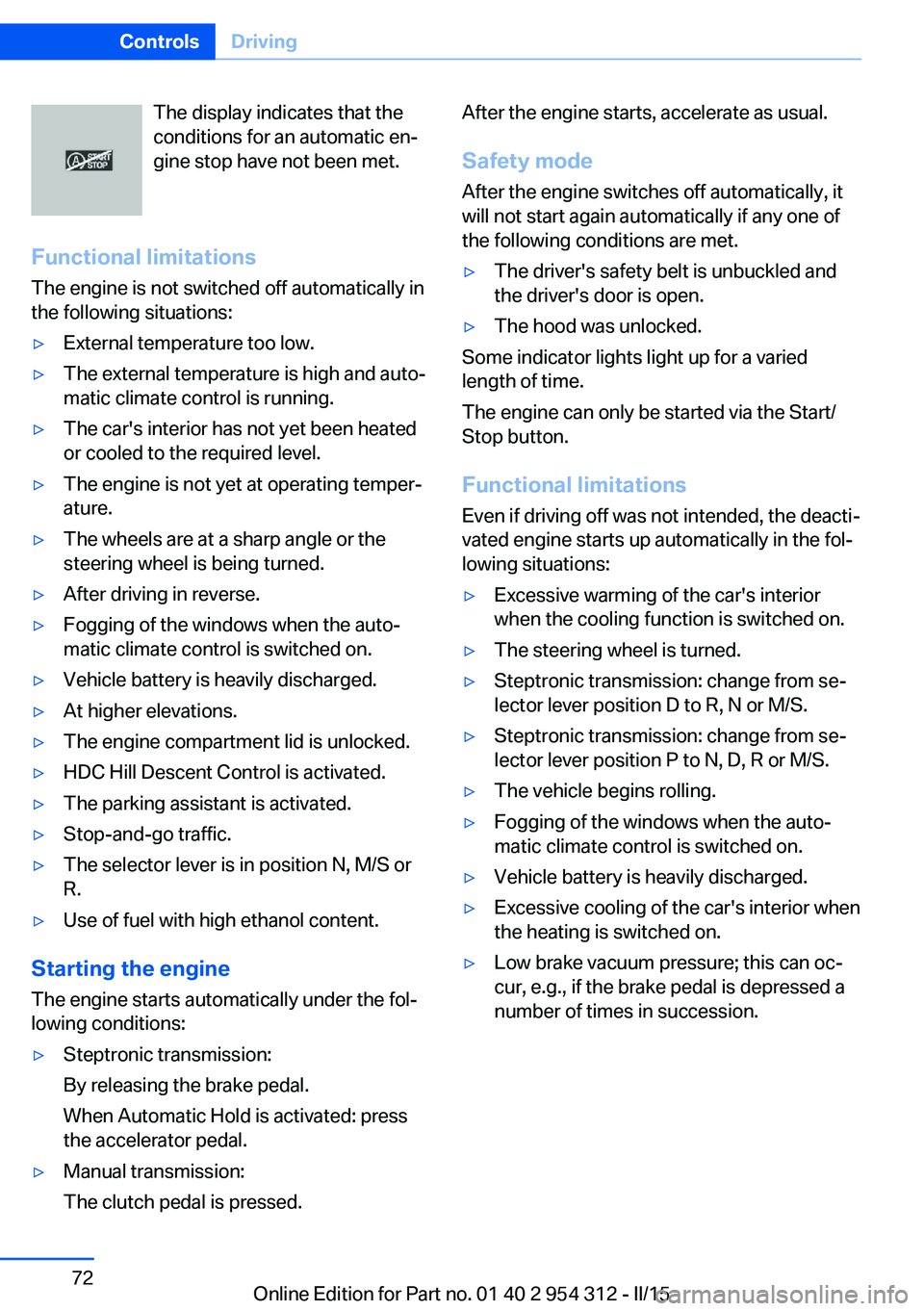
The display indicates that the
conditions for an automatic en‚Äź
gine stop have not been met.
Functional limitations
The engine is not switched off automatically in
the following situations:‚Ė∑External temperature too low.‚Ė∑The external temperature is high and auto‚Äź
matic climate control is running.‚Ė∑The car's interior has not yet been heated
or cooled to the required level.‚Ė∑The engine is not yet at operating temper‚Äź
ature.‚Ė∑The wheels are at a sharp angle or the
steering wheel is being turned.‚Ė∑After driving in reverse.‚Ė∑Fogging of the windows when the auto‚Äź
matic climate control is switched on.‚Ė∑Vehicle battery is heavily discharged.‚Ė∑At higher elevations.‚Ė∑The engine compartment lid is unlocked.‚Ė∑HDC Hill Descent Control is activated.‚Ė∑The parking assistant is activated.‚Ė∑Stop-and-go traffic.‚Ė∑The selector lever is in position N, M/S or
R.‚Ė∑Use of fuel with high ethanol content.
Starting the engine
The engine starts automatically under the fol‚Äź
lowing conditions:
‚Ė∑Steptronic transmission:
By releasing the brake pedal.
When Automatic Hold is activated: press
the accelerator pedal.‚Ė∑Manual transmission:
The clutch pedal is pressed.After the engine starts, accelerate as usual.
Safety mode
After the engine switches off automatically, it
will not start again automatically if any one of
the following conditions are met.‚Ė∑The driver's safety belt is unbuckled and
the driver's door is open.‚Ė∑The hood was unlocked.
Some indicator lights light up for a varied
length of time.
The engine can only be started via the Start/
Stop button.
Functional limitations
Even if driving off was not intended, the deacti‚Äź
vated engine starts up automatically in the fol‚Äź
lowing situations:
‚Ė∑Excessive warming of the car's interior
when the cooling function is switched on.‚Ė∑The steering wheel is turned.‚Ė∑Steptronic transmission: change from se‚Äź
lector lever position D to R, N or M/S.‚Ė∑Steptronic transmission: change from se‚Äź
lector lever position P to N, D, R or M/S.‚Ė∑The vehicle begins rolling.‚Ė∑Fogging of the windows when the auto‚Äź
matic climate control is switched on.‚Ė∑Vehicle battery is heavily discharged.‚Ė∑Excessive cooling of the car's interior when
the heating is switched on.‚Ė∑Low brake vacuum pressure; this can oc‚Äź
cur, e.g., if the brake pedal is depressed a
number of times in succession.Seite 72ControlsDriving72
Online Edition for Part no. 01 40 2 954 312 - II/15
Page 84 of 277
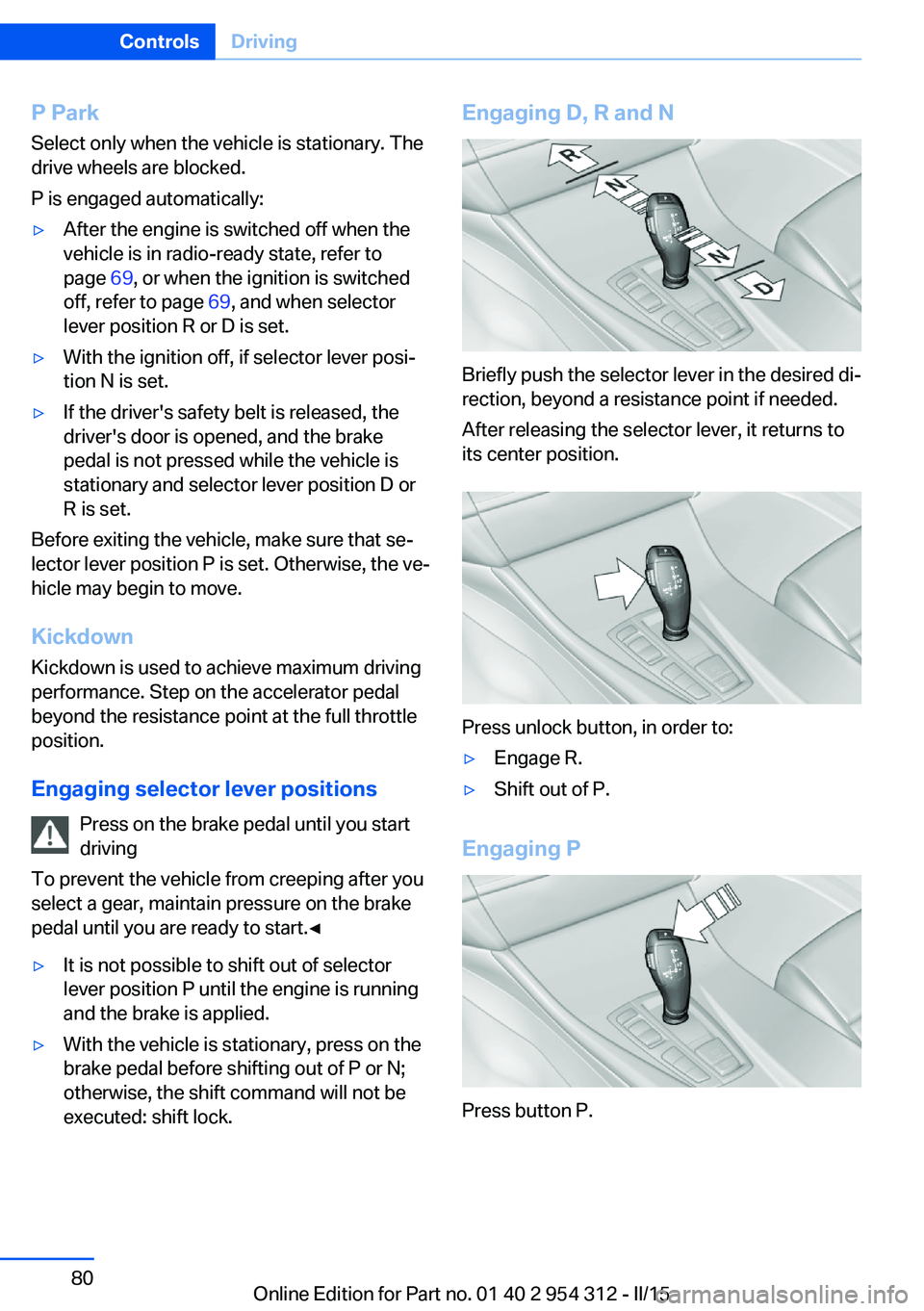
P ParkSelect only when the vehicle is stationary. The
drive wheels are blocked.
P is engaged automatically:‚Ė∑After the engine is switched off when the
vehicle is in radio-ready state, refer to
page 69, or when the ignition is switched
off, refer to page 69, and when selector
lever position R or D is set.‚Ė∑With the ignition off, if selector lever posi‚Äź
tion N is set.‚Ė∑If the driver's safety belt is released, the
driver's door is opened, and the brake
pedal is not pressed while the vehicle is
stationary and selector lever position D or
R is set.
Before exiting the vehicle, make sure that se‚Äź
lector lever position P is set. Otherwise, the ve‚Äź
hicle may begin to move.
Kickdown Kickdown is used to achieve maximum driving
performance. Step on the accelerator pedal
beyond the resistance point at the full throttle
position.
Engaging selector lever positions Press on the brake pedal until you start
driving
To prevent the vehicle from creeping after you
select a gear, maintain pressure on the brake
pedal until you are ready to start.‚óÄ
‚Ė∑It is not possible to shift out of selector
lever position P until the engine is running
and the brake is applied.‚Ė∑With the vehicle is stationary, press on the
brake pedal before shifting out of P or N;
otherwise, the shift command will not be
executed: shift lock.Engaging D, R and N
Briefly push the selector lever in the desired di‚Äź
rection, beyond a resistance point if needed.
After releasing the selector lever, it returns to
its center position.
Press unlock button, in order to:
‚Ė∑Engage R.‚Ė∑Shift out of P.
Engaging P
Press button P.
Seite 80ControlsDriving80
Online Edition for Part no. 01 40 2 954 312 - II/15
Page 86 of 277
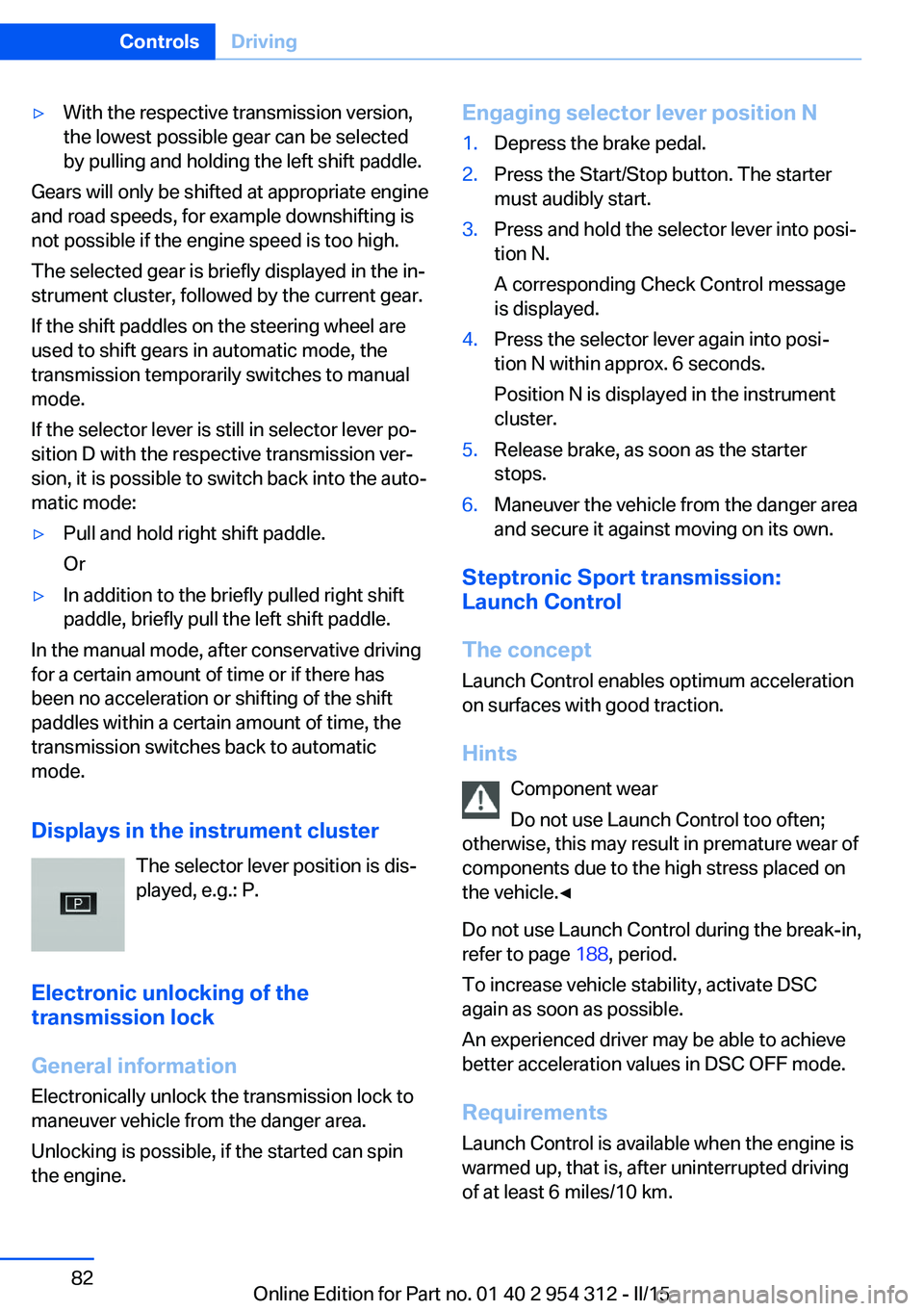
‚Ė∑With the respective transmission version,
the lowest possible gear can be selected
by pulling and holding the left shift paddle.
Gears will only be shifted at appropriate engine
and road speeds, for example downshifting is
not possible if the engine speed is too high.
The selected gear is briefly displayed in the in‚Äź
strument cluster, followed by the current gear.
If the shift paddles on the steering wheel are
used to shift gears in automatic mode, the
transmission temporarily switches to manual
mode.
If the selector lever is still in selector lever po‚Äź
sition D with the respective transmission ver‚Äź
sion, it is possible to switch back into the auto‚Äź
matic mode:
‚Ė∑Pull and hold right shift paddle.
Or‚Ė∑In addition to the briefly pulled right shift
paddle, briefly pull the left shift paddle.
In the manual mode, after conservative driving
for a certain amount of time or if there has
been no acceleration or shifting of the shift
paddles within a certain amount of time, the
transmission switches back to automatic
mode.
Displays in the instrument cluster The selector lever position is dis‚Äź
played, e.g.: P.
Electronic unlocking of the
transmission lock
General information
Electronically unlock the transmission lock to
maneuver vehicle from the danger area.
Unlocking is possible, if the started can spin
the engine.
Engaging selector lever position N1.Depress the brake pedal.2.Press the Start/Stop button. The starter
must audibly start.3.Press and hold the selector lever into posi‚Äź
tion N.
A corresponding Check Control message
is displayed.4.Press the selector lever again into posi‚Äź
tion N within approx. 6 seconds.
Position N is displayed in the instrument
cluster.5.Release brake, as soon as the starter
stops.6.Maneuver the vehicle from the danger area
and secure it against moving on its own.
Steptronic Sport transmission:
Launch Control
The concept Launch Control enables optimum accelerationon surfaces with good traction.
Hints Component wear
Do not use Launch Control too often;
otherwise, this may result in premature wear of
components due to the high stress placed on
the vehicle.‚óÄ
Do not use Launch Control during the break-in,
refer to page 188, period.
To increase vehicle stability, activate DSC
again as soon as possible.
An experienced driver may be able to achieve
better acceleration values in DSC OFF mode.
Requirements Launch Control is available when the engine is
warmed up, that is, after uninterrupted driving
of at least 6 miles/10 km.
Seite 82ControlsDriving82
Online Edition for Part no. 01 40 2 954 312 - II/15